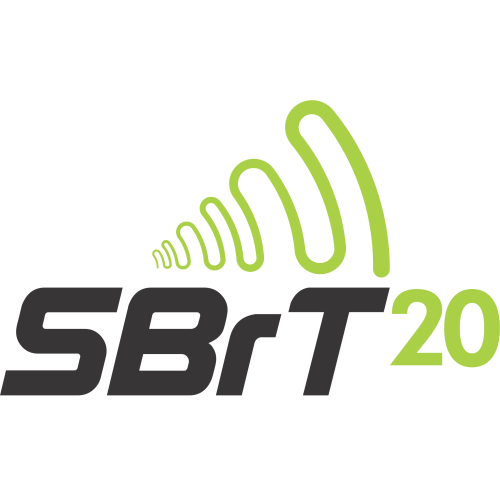
XXXVIII Simpósio Brasileiro de Telecomunicações e Processamento de Sinais

Preliminary Studies on the Large Intelligent Surfaces Efficiencies Under Different Channels
Michelle Soares Pereira Facina, Gustavo Fraidenraich
DOI: 10.14209/SBRT.2020.1570656693
Keywords:
Abstract
This work investigates the impact of the channel model, and power allocation on the performance of a system employing Large Intelligent Surfaces (LIS). Most of the previous studies have considered the energy efficiency of such systems under the influence of Rayleigh channels and Zero-Forcing (ZF) precoding. We present results for Rice channels and Matched Filter (MF) receiver showing a surprising reduction in energy efficiency. We also derive an accurate approximation for spectral efficiency when the equal power allocation strategy is employed. According to our simulations, a loss of 6 dB is observed when the symbols are transmitted with the same power.Download

Simulador Radar baseado no software Blender
Raíssa Andrade, Rômulo Fernandes da Costa, Renato Machado
DOI: 10.14209/SBRT.2020.1570656801
Keywords: SABER modelagem 3D equação radar path tracing
Abstract
This article demonstrates the validation of some elementary concepts of radar theory using a simulator based on the open-source 3D modeling software Blender. From a simply built 3D scene, it is possible to verify target detection, fading of the simulated radar signal, and features related to the system's spatial resolution, as it is provided by the theoretical model.Download

Antena Multibanda Semi-Espiral CPW para Aplicações no 5G sub-6 GHz
Valdemir Praxedes da Silva Neto, Jose Garibaldi Duarte Jr.
DOI: 10.14209/SBRT.2020.1570656813
Keywords: Multiband Spiral CPW 5G sub-6 GHz
Abstract
Modern wireless communication systems increasingly need radio frequency devices capable of meeting their operating specifications. In this work, an antenna with multiband characteristics based on semi-spiral geometry and coplanar waveguide feed line is proposed for applications in the 5G sub-6 GHz standards. A study is done on the physical parametersof the spiral patch and feed line geometry. The prototype built was subjected to measurement where four operating bands were obtained, which were centered at 1.36, 1.71, 2.47 and 3.65 GHz, therefore, possibly applicable in the specified standardsDownload
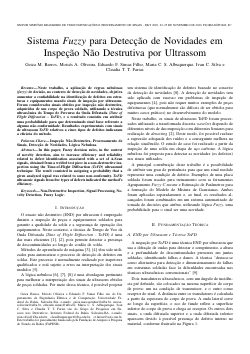
Sistema Fuzzy para Detecção de Novidades em Inspeção Não Destrutiva por Ultrassom
Geiza M. de Barros, Moises A Oliveira, Eduardo Simas Filho, Maria Cléa Albuquerque, Ivan Silva, Cláudia Teresa Farias
DOI: 10.14209/SBRT.2020.1570656856
Keywords: Inspeção Não-Destrutiva Processamento de Sinais Detecção de Novidades Lógica Nebulosa
Abstract
In this paper, Fuzzy decision rules, in the context of novelty detection, aims to increase efficiency and reliability related to defect identification associated with a set of A-Scan signals, obtained from a welded test piece in a non-destructive inspection using the Time-of-Flight Diffraction (ToFD) ultrasound technique. The training process only required samples without defects, and the result consisted in assigning a probability that a given analyzed signal was related to some non-conformity. ToFD ultrasonic signals from five types of defects indicated the method's efficiency.Download
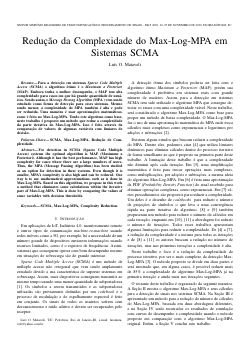
Redução da Complexidade do Max-Log-MPA em Sistemas SCMA
Luis Mataveli
DOI: 10.14209/SBRT.2020.1570657286
Keywords: SCMA Max-Log-MPA Redução de Complexidade
Abstract
For detection in SCMA (Sparse Code Multiple Access) systems the optimal algorithm is MAP (Maximum a Posteriori). Although it has the best performance, MAP has high complexity for cases where there are a large numbers of users. Thus, the MPA (Message Passing Algorithm) has been studied as an option for detection in these systems. Even though it is smaller, MPA's complexity is also high and can be reduced. One way is to use mathematical approximations, such as is done in Max-Log-MPA. Based on this algorithm, we propose in this work a method that eliminates some calculations within the iterative part of Max-Log-MPA. This is done by comparing the values of some variables with decision thresholds.Download
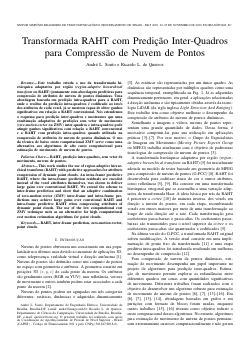
Transformada RAHT com Predição Inter-Quadros para Compressão de Nuvem de Pontos
André L Souto, Ricardo L de Queiroz
DOI: 10.14209/SBRT.2020.1570657479
Keywords:
Abstract
This work studies the use of region adaptive hierarchical transform (RAHT) with predictive approaches for attribute compression of dynamic point clouds. An intra-frame predictive RAHT, where the intra-frame prediction residuals are encoded instead of the voxel attributes themselves, was shown to deliver large gains over conventional RAHT. We extend the scheme to inter-frame prediction and show that an adaptive combination of zero-motion-vector (ZMV) inter-frame and intra-frame predictions may achieve large gains over convetional RAHT and intra-frame predictive RAHT when compressing attributes of dynamic point clouds. The use of the low computational cost ZMV technique suits as an alternative for high computational cost motion estimation algorithms for point clouds.Download

Blind Source Separation based on Semblance Beamforming
Alexandre Miccheleti Lucena, Kenji Nose Filho, Ricardo Suyama
DOI: 10.14209/SBRT.2020.1570657503
Keywords: source separation beamforming semblance source cancellation
Abstract
The source separation task has been tackled from different approaches, including beamforming. The idea of exploiting geometric information of the sensors may contribute in convolutive mixture separation context, usually assumed in real scenario. This work proposes a beamformer algorithm for source separation based on the semblance coherence function. The performance of the algorithm for artificially mixed signals is evaluated using a objective intelligibility metric throughout Monte Carlo simulations in two scenarios and different SNR levels. Results are compared with classic techniques: GSS and Delay and Sum, where the proposed algorithm achieves the best performance under no influence of additive noise.Download
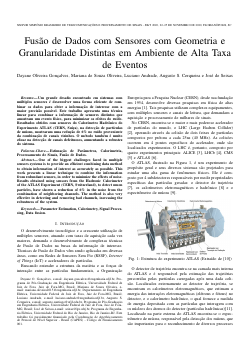
Fusão de Dados com Sensores com Geometria e Granularidade Distintas em Ambiente de Alta Taxa de Eventos
Dayane Oliveira Gonçalves, Mariana de Souza Oliveira, Luciano Andrade, Augusto S Cerqueira, José de Seixas
DOI: 10.14209/SBRT.2020.1570657577
Keywords: Estimação de Parâmetros Calorimetria Processamento de Sinais Fusão de Dados
Abstract
One of the biggest challenges faced in multiple sensors systems is to provide an efficient combining data method to obtain information of interest as accurately as possible. This work presents a linear technique to combine the information from redundant sensors, in order to minimize the effects of noise. Results obtained using sensors from the Hadronic Calorimeter of the ATLAS Experiment (CERN, Switzerland), to detect muon particles, have shown a reduction of 6% in the noise from the combination of neighboring channels. The method is also very effective in detecting and removing bad channels, increasing the robustness of the system.Download
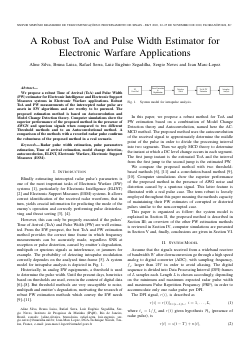
A Robust ToA and Pulse Width Estimator for Electronic Warfare Applications
Aline de Oliveira Pinto Silva, Rafael de Figueirêdo, Luiz Eugênio Segadilha, Sergio Neves, Jean Marc-Lopez
DOI: 10.14209/SBRT.2020.1570657578
Keywords: Electronic Warfare ToA Estimation Pulse Width Estimation ELINT
Abstract
We propose a robust Time of Arrival (ToA) and Pulse Width (PW) estimator for Electronic Intelligence (ELINT) and Electronic Support Measures (ESM) systems in Electronic Warfare (EW) applications. Robust ToA and PW measurements of the intercepted radar pulse are assets in EW algorithms and are worthy to be pursued. The proposed estimation method is based on Autoconvolution (AC) and Model Change Detection (MCD) theory. Computer simulations show the superior performance of the proposed method in the presence of AWGN and spurious signals when compared to a Histogram and Mean-Based Threshold methods and a Autoconvolutional method. A comparison of the methods with a recorded radar pulse confirms the robustness of the proposed method in a real scenario.Download

Comparações de modelo epidêmico suscetível-infectado em redes reais e aleatórias
Rodrigo M Malagutti, Marcio Eisencraft
DOI: 10.14209/SBRT.2020.1570657814
Keywords: Epidemic models Complex networks Susceptible-infected Random networks
Abstract
This paper aims to relay the results from computer simulations of mechanisms for gradual transmission of epidemics with the susceptible-infected model over real networks in comparison to random ones. In particular, networks from the models of Erdos-Renyi, Watts-Strogatz (small world) and Barabási-Albert (scale free) are analyzed. By changing contamination parameters and network properties, it is possible to notice an increase in contamination potential as the networks approach human patterns of organization.Download